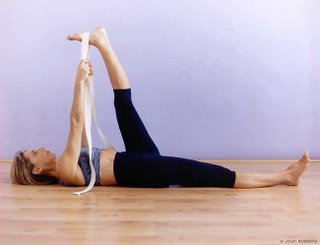Supta Padangusthasana

First, off, this is not me.
This is a perfect model from one of the popular yoga magazines' websites. I'm allowing her to be present because she provides a great visual of a pose I taught today, Supta Padangusthasana.
I usually begin my class with quiet: a few minutes of sitting comfortably on the mat at the beginning of class. It's probably one of the only moments that most of us sit still all week long.
Some Saturdays it can be uncomfortably silent in the room, or blissfully peaceful, or even raucous and silly, such as those meditative opportunities broken into by the sound of the Moose Club tossing their empties from Friday night rousings into the dumpster
Today, between the cool autumn air, the small size of the group, and the seasonal sense of everything slowing down, all felt restful before we began.
Instead of sitting quietly, we started out with Supta Padangusthasana: a pose that stretches the hamstrings and fronts of the legs, begins to release the hips and shoulders, and stretches the soles of the feet.
Like the model, lie on your back, extend the left leg into the mat, bring a strap around the ball of your right foot and extend the right heel to the ceiling . Slide your hands down the strap until your elbows are grounded.
Why the strap, you may be wondering? Well, for most of us, we are not sufficiently limber to hold onto our foot and straighten the leg. Thus, strap supplements arm quite nicely.
Now, the work begins. Extend your heel, point your toes more at your forehead, press the left leg into the mat, straighten the right leg. Extend the heel again, and straighten the leg again, because it is so darned lazy and would rather relax than work. Then straighten the left leg again, press out through the heel of the left foot, press the thigh bone into the mat. Because while you were paying attention to the right leg, the left leg was shirking.
Breathe, because at this point you've probably lost any attention to a smooth, rhythmic breath.
Release. Repeat on the other side. This time, the mind is a bit more willing: it knows the score and has a hazy sense of how long the pose will last, so all seems a bit more reassuring. This is an illusion, however, because each side, each pose, each moment will be different that what one expects.
That's one of the rewards of a yoga practice: you learn, by working so intently on controlling the body, that control is elusive, and not all that important after all. Process, not end result.
And, by dividing time into individual breaths in and out, you build into your experience that every moment is living, instead of life being something out there that you are waiting to achieve.
Now, Savasana, or final relaxation. Lie down on your back. Close your eyes, let the feet flop to the side, relax your jaw. Take a deep breath, exhale. And then, allow yourself to be still for at least five minutes.
And it's fine to have silence. Just like the staying still part, try to think back to the last time you sat with no sound, no stimulation from television or radio or conversation. Notice the many sounds that you miss when you fill each moment with noise.
Emptiness is okay.
Comments